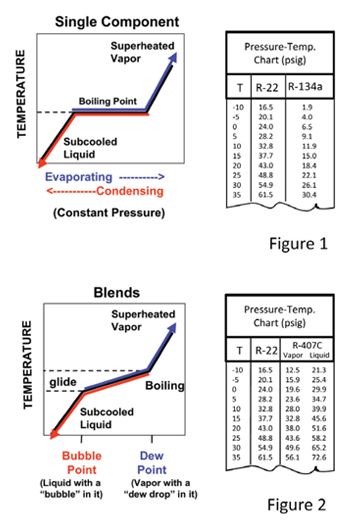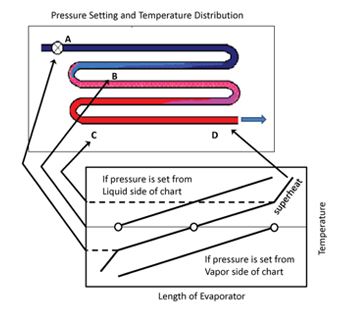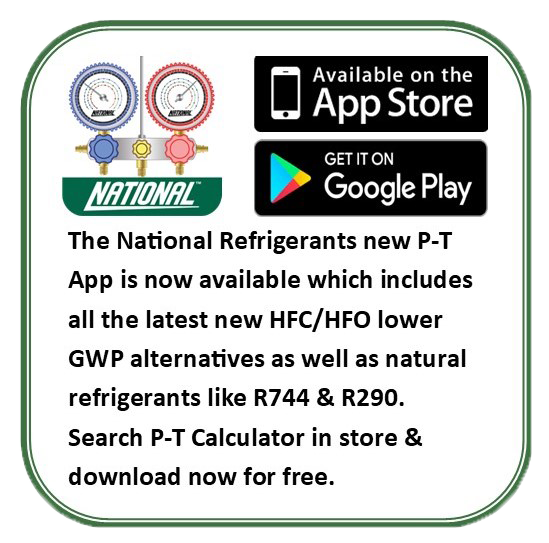How to Use a Two-Column, Pressure-Temperature Chart
By Jim Lavelle
Because the properties of the new zeotropic refrigerant blends are different than traditional refrigerants, it is useful to know how to read a two-column PT chart.
The pressure-temperature (PT) chart is a valuable tool that service technicians use to check proper system operation. PT charts are most often used for three purposes: to set a coil pressure so that the refrigerant produces the desired temperature; to check the amount of superheat above the saturated vapor condition at the outlet of the evaporator and to check the amount of subcooling below the saturated liquid condition at the end of the condenser.
Traditional PT charts list the saturated refrigerant pressure, in psig, with a column for temperature down the left side. Single-component refrigerants and azeotropes boil and condense at one temperature for a given pressure. Therefore, only one column is needed to show the pressure-temperature relationship for any phase-change process in a system (see Fig. 1).
The properties of the new zeotropic blends are somewhat different than the traditional refrigerants. Zeotropic blends shift in composition during the boiling or condensing process (see Fig. 2). As the blend changes phase, more of one component will transfer to the other phase faster than the rest.
This property is called fractionation. The changing composition of the liquid causes the boiling point temperature to shift as well. The overall shift of temperature from one side of the heat exchanger to the other is called the temperature glide.
Zeotropic blends cannot be defined by a single pressure-temperature relationship. The temperature glide will cause different values for temperature at a given pressure, depending on how much refrigerant is liquid and how much is vapor. The most important values for checking superheat and subcool are the end points of the glide or the pressure-temperature relationship for saturated liquid and saturated vapor.
The saturated liquid condition is often referred to as the bubble point. Imagine a pot of liquid sitting on a stove; as it begins to boil it forms bubbles in the liquid. The saturated vapor condition is referred to as the dew point. Imagine a room full of vapor and dew drops forming on the furniture. PT charts for the zeotropic blends list two columns next to each temperature: one for the saturated liquid (bubble point) and the other for the saturated vapor (dew point).
Some of the zeotropic blends have very low glide (from 1*F to 2.5*F). For these blends, the vapor and liquid pressures are only separated by 1 or 2 psi. Because the difference is quite small between the two values some manufacturers' PT charts will only list one column for these blends. Blends with higher glide (greater than 5*F) will generally have both columns listed.

Using a Two-Column PT Chart
When checking a superheat or subcool temperature the procedure is the same as for a single-component refrigerant. Superheat is checked by measuring the temperature of the vapor line, measuring the pressure, then subtracting the saturated temperature from the measured temperature. In the case of a blend, you simply read the saturated temperature next to the pressure in the vapor (dew point) column of the chart.
When checking the subcool condition, the technician will measure the temperature of the liquid line, the pressure at that point and subtract the measured temperature from the saturated temperature at the end of the condenser. With the blend you read the saturated temperature next to the pressure in the liquid (bubble point) column of the chart.
For a single-component or azeotropic refrigerant, the operating pressure of the low side of a system can be found by cross referencing the desired coil temperature on the PT chart. For high-glide blends, however, the desired coil temperature is the average (or midpoint) temperature of the coil.
The problem with two-column PT charts is that the conditions at the endpoints of the temperature glide are listed, not the midpoint. In this case, you must add half of the temperature glide to the desired midpoint temperature, then read the saturated vapor column to determine the operating pressure (see Fig 3).

If the vapor column is read directly at the desired temperature, then the end of the evaporator will be the correct temperature, but the rest of the coil will be too cold. If the liquid column is used directly, then the beginning of the coil will be the correct temperature, but the rest of the coil will be too warm.
Two-column PT charts are every bit as useful as the traditional ones. The charging and service procedures are very similar for both single-component refrigerants and zeotropic blends, and the specialized liquid and vapor data correct for the effects of the blends' temperature glide.
Just remember to keep track of the phase of the blend at the point you are interested: saturated vapor uses the vapor (dew point) column and saturated liquid uses the liquid (bubble point) column.
For further information, please contact us.





